Aziridine-2,3-dicarboxylates, peptidomimetic cysteine protease inhibitors with antileishmanial activity
- PMID: 16801424
- PMCID: PMC1489792
- DOI: 10.1128/AAC.01430-05
Aziridine-2,3-dicarboxylates, peptidomimetic cysteine protease inhibitors with antileishmanial activity
Abstract
Chemotherapy of leishmaniasis is mainly based on antimonials. However, they are extremely toxic and cause serious side effects, and there is a worldwide increasing frequency of chemoresistance to antimonials. These issues emphasize the urgent need for affordable alternative drugs against leishmaniasis. Leishmania cysteine proteases are essential for parasite growth, differentiation, pathogenicity, and virulence and are thus attractive targets for combating leishmaniasis. Herein we demonstrate that the cysteine protease inhibitors aziridine-2,3-dicarboxylates 13b and 13e impaired promastigote growth at mid-micromolar concentrations and decreased the infection rate of peritoneal macrophages at concentrations 8- to 13-fold lower than those needed to inhibit parasite replication. Simultaneous treatment of infected cells with compound 13b and gamma interferon resulted in an even further reduction of the concentration needed for a significant decrease in macrophage infection rate. Notably, treatment with the compounds alone modulated the cytokine secretion of infected macrophages, with increased levels of interleukin-12 and tumor necrosis factor alpha. Furthermore, the decreased infection rate in the presence of compound 13b correlated with increased nitric oxide production by macrophages. Importantly, at the concentrations used herein, compounds 13b and 13e were not toxic against fibroblasts, macrophages, or dendritic cells. Together, these results suggest that the aziridine-2,3-dicarboxylates 13b and 13e are potential antileishmanial lead compounds with low toxicity against host cells and selective antiparasitic effects.
Figures

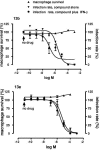
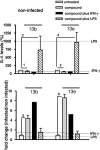
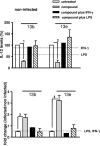
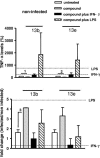
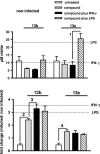
Similar articles
-
Activities of naphthylisoquinoline alkaloids and synthetic analogs against Leishmania major.Antimicrob Agents Chemother. 2007 Jan;51(1):188-94. doi: 10.1128/AAC.00936-06. Epub 2006 Nov 6. Antimicrob Agents Chemother. 2007. PMID: 17088484 Free PMC article.
-
Development of a New Antileishmanial Aziridine-2,3-Dicarboxylate-Based Inhibitor with High Selectivity for Parasite Cysteine Proteases.Antimicrob Agents Chemother. 2015 Nov 23;60(2):797-805. doi: 10.1128/AAC.00426-15. Print 2016 Feb. Antimicrob Agents Chemother. 2015. PMID: 26596939 Free PMC article.
-
Aziridine-2,3-dicarboxylate-based cysteine cathepsin inhibitors induce cell death in Leishmania major associated with accumulation of debris in autophagy-related lysosome-like vacuoles.Antimicrob Agents Chemother. 2010 Dec;54(12):5028-41. doi: 10.1128/AAC.00327-10. Epub 2010 Sep 20. Antimicrob Agents Chemother. 2010. PMID: 20855728 Free PMC article.
-
Antileishmanial activity and immune modulatory effects of tannins and related compounds on Leishmania parasitised RAW 264.7 cells.Phytochemistry. 2005 Sep;66(17):2056-71. doi: 10.1016/j.phytochem.2005.01.011. Phytochemistry. 2005. PMID: 16153409 Review.
-
Targeting cysteine protease B to discover antileishmanial drugs: Directions and advances.Eur J Med Chem. 2025 May 5;289:117500. doi: 10.1016/j.ejmech.2025.117500. Epub 2025 Mar 11. Eur J Med Chem. 2025. PMID: 40085977 Review.
Cited by
-
Activities of naphthylisoquinoline alkaloids and synthetic analogs against Leishmania major.Antimicrob Agents Chemother. 2007 Jan;51(1):188-94. doi: 10.1128/AAC.00936-06. Epub 2006 Nov 6. Antimicrob Agents Chemother. 2007. PMID: 17088484 Free PMC article.
-
A novel Leishmania major amastigote assay in 96-well format for rapid drug screening and its use for discovery and evaluation of a new class of leishmanicidal quinolinium salts.Antimicrob Agents Chemother. 2013 Jul;57(7):3003-11. doi: 10.1128/AAC.02201-12. Epub 2013 Apr 15. Antimicrob Agents Chemother. 2013. PMID: 23587955 Free PMC article.
-
Current developments in the therapy of protozoan infections.Open Med Chem J. 2011;5:4-10. doi: 10.2174/1874104501105010004. Epub 2011 Mar 9. Open Med Chem J. 2011. PMID: 21629507 Free PMC article.
-
Identification of plakortide E from the Caribbean sponge Plakortis halichondroides as a trypanocidal protease inhibitor using bioactivity-guided fractionation.Mar Drugs. 2014 May 2;12(5):2614-22. doi: 10.3390/md12052614. Mar Drugs. 2014. PMID: 24798927 Free PMC article.
-
Evaluation of the Leishmanicidal Activity of Rutaceae and Lauraceae Ethanol Extracts on Golden Syrian Hamster (Mesocricetus auratus) Peritoneal Macrophages.Indian J Pharm Sci. 2014 May;76(3):188-97. Indian J Pharm Sci. 2014. PMID: 25035529 Free PMC article.
References
-
- Ahmed, S. A., R. M. Gogal, and J. E. Walsh. 1994. A new rapid and simple non-radioactive assay to monitor and determine the proliferation of lymphocytes: an alternative to [3H]thymidine incorporation assay. J. Immunol. Methods 170:211-224. - PubMed
-
- Alves, C. R., T. C. Benevolo-De-Andrade, J. L. Alves, and C. Pirmez. 2004. Th1 and Th2 immunological profile induced by cysteine proteinase in murine leishmaniasis. Parasite Immunol. 26:127-135. - PubMed
-
- Ascenzi, P., A. Bocedi, M. Gentile, P. Visca, and L. Gradoni. 2004. Inactivation of parasite cysteine proteinases by the NO-donor 4-(phenylsulfonyl)-3-((2-(dimethylamino)ethyl)thio)-furoxan oxalate. Biochim. Biophys. Acta 1703:69-77. - PubMed
-
- Bates, P. A., C. D. Robertson, and G. H. Coombs. 1994. Expression of cysteine proteinases by metacyclic promastigotes of Leishmania mexicana. J. Eukaryot. Microbiol. 41:199-203. - PubMed
-
- Belkaid, Y., B. Butcher, and D. L. Sacks. 1998. Analysis of cytokine production by inflammatory mouse macrophages at the single-cell level: selective impairment of IL-12 induction in Leishmania-infected cells. Eur. J. Immunol. 28:1389-1400. - PubMed
Publication types
MeSH terms
Substances
LinkOut - more resources
Full Text Sources

